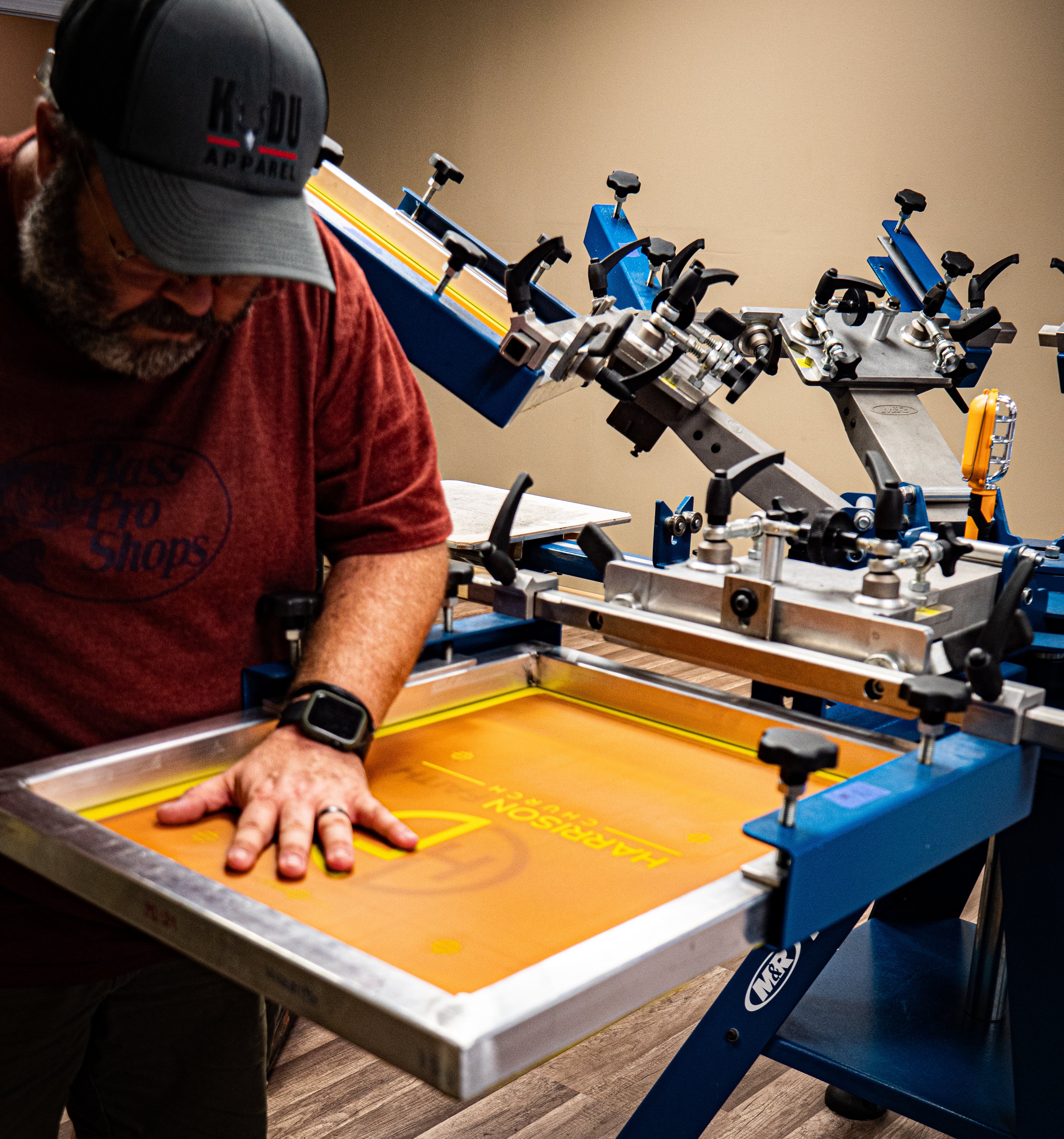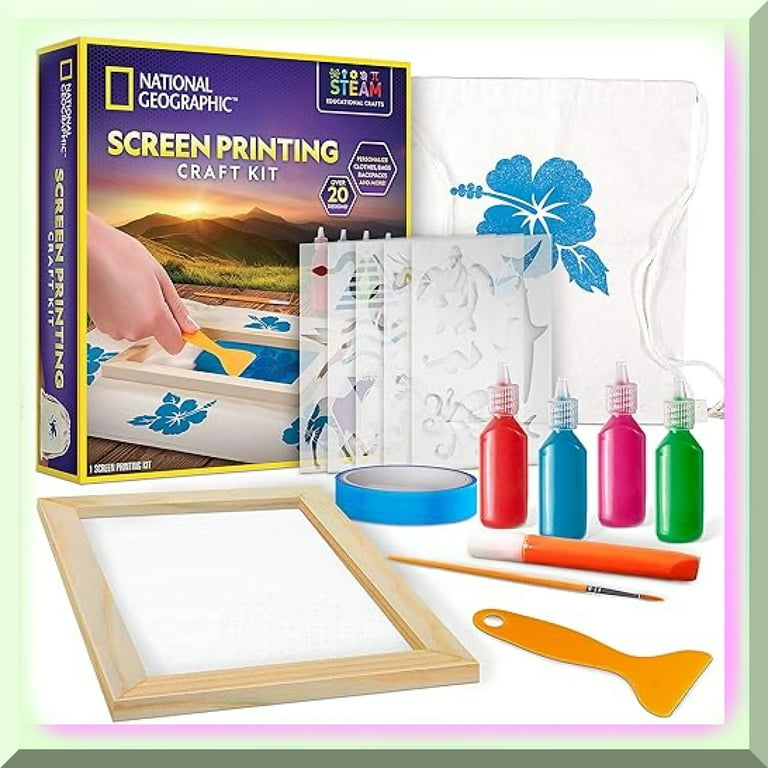Affordable Custom Screen Printing Services for Small Businesses
Wiki Article
Display Printing Uncovered: Whatever You Need to Understand About T-Shirt and Garment Printing Techniques
Screen printing is a remarkable technique that incorporates art with technique, supplying limitless possibilities for creative thinking. Prepared to discover the necessary aspects that make display printing an art kind?
The Essentials of Screen Printing: How It Functions
When you plunge into screen printing, you'll find it's both a scientific research and an art. At its core, screen printing includes developing a pattern, or screen, that enables ink to pass via just in certain areas.Setting the display over the textile, then use a squeegee to push ink via the display onto the garment. Each step is necessary, and understanding them will certainly boost your display printing abilities, transforming easy garments into distinct, meaningful items.
Sorts Of Display Printing Techniques
Once you understand the fundamentals of screen printing, it's time to explore the numerous methods that can boost your styles. One preferred approach is conventional display printing, where ink is pushed through a stenciled display.Another option is plastisol printing, understood for its toughness and vibrant colors, making it a favored for many brands. Experiment with halftone printing to produce gradient effects and complex designs.
Crucial Tools for Screen Printing
To accomplish sensational lead to display printing, having the ideal tools is essential. You'll need a durable display printing frame, which holds the mesh that moves your design onto the garment. Next off, buy top quality mops; these are necessary for using ink uniformly throughout the screen. You'll likewise need a good exposure unit to create your displays, along with a washout booth for cleansing them after use. A dependable warm source, like a conveyor clothes dryer or warm press, is crucial for curing your prints to guarantee longevity. Do not forget a correct work space, geared up with tables and storage space for your products. Ultimately, safety equipment, such as handwear covers and masks, will certainly keep you risk-free from chemicals and inks. With the right tools, you'll be well on your means to generating professional-quality prints.Selecting the Right Inks and Products
When selecting inks and products for display printing, you require to think about the kind of ink that works ideal for your job. Think of textile compatibility to ensure your designs look last and fantastic long. Additionally, discover green ink choices to make your printing procedure much more lasting.Types of Screen Inks
Choosing the appropriate screen ink is important for accomplishing vivid, sturdy prints that meet your task's requirements. There are a number of kinds of display inks to analyze. Plastisol ink is popular for its flexibility and ease of usage, giving superb shade opacity on dark fabrics. Water-based ink, on the various other hand, offers a softer feeling and is environment-friendly, making it excellent for those seeking to reduce their environmental impact. Discharge inks remove dye from the textile, causing a soft, vintage look however require specific handling. Finally, specialized inks, such as metallic or glow-in-the-dark, can include unique impacts to your layouts. Evaluate your task needs and choose the ink that straightens finest with your wanted result.
Material Compatibility Considerations
Comprehending textile compatibility is important for achieving premium display prints, particularly because different materials react distinctively to numerous inks. When picking inks, think about the textile type-- cotton, polyester, or blends. For cotton, water-based inks function well, using softness and breathability. Polyester, on the other hand, usually needs plastisol inks for far better adhesion and dynamic shades. You might need to utilize a combination of both types if you're printing on blends. Constantly examine your inks on example material to assure they adhere correctly and maintain shade stability. In addition, keep in mind that fabric weight and structure can affect the last end result, so selecting the right ink and product combo is vital for your project's success.Eco-Friendly Ink Options
Green inks are coming to be a prominent selection for display printers that wish to decrease their ecological influence while maintaining quality. When selecting inks, think about water-based inks, which are less dangerous and less complicated to tidy up compared to standard solvents. These inks bond well with materials, supplying vibrant results without toxic chemicals. You may likewise discover eco-solvent inks that use fewer unstable organic compounds (VOCs), making them a safer choice for both your wellness and the world.Furthermore, search for inks made from eco-friendly sources, such as soy or vegetable-based choices. By choosing the right inks and materials, you'll not only create sensational layouts but additionally add to a more sustainable printing process. Make the switch, and your prints will mirror your dedication to the atmosphere!
Preparing Your Design for Display Printing

File Layout Needs
To guarantee your layout looks lively and sharp on material, you'll require to pay close attention to submit layout demands for display printing. Make certain your design has a transparent background to prevent undesirable white sides on your prints. Keep shade modes in mind; CMYK is standard for display printing, so convert your RGB creates as necessary.Color Separation Methods
Color separation is a vital step in preparing your design for screen printing, and mastering it can considerably boost your print high quality. You'll require to damage your layout into specific colors, as each shade calls for a separate screen throughout printing. This precision not only assures exact color representation however custom screen printing additionally streamlines the printing process.Resolution and Dimension
Achieving the most effective cause screen printing begins with guaranteeing your style has the right resolution and dimension. Preferably, your art work needs to go to least 300 DPI (dots per inch) for sharp, clear prints. Your last product might look amateur and pixelated. if you use reduced resolution.When it involves size, take into consideration the measurements of your print area. Design your art work to match the final print size, ideally producing it in the actual measurements you'll be publishing. In this manner, you'll avoid any unanticipated scaling concerns.
Constantly check your style in both vector and raster layouts. Vector graphics can be scaled without shedding quality, making them suitable for display printing. Preparing correctly will assure your design looks incredible on every garment!
Step-by-Step Screen Printing Process
Screen printing is a dynamic process that permits you to develop lively designs on various surface areas. To obtain begun, you'll need a display, solution, and your chosen ink.Put ink onto the screen and make use of a squeegee to push the ink with the stencil onto the material. Lift the screen very carefully and allow the print completely dry. You have actually efficiently display published your style.
Tips for Effective Screen Printing Projects
While you're diving right into your display printing tasks, bear in mind that preparation is crucial to success. Beginning by gathering all your materials-- inks, displays, squeegees, and garments. A clean work space helps prevent undesirable mistakes, so neat up before you begin.Following, confirm your art work is high-resolution and appropriately sized for your garment. Check your screen for appropriate exposure and tidy it completely to stay clear of spots. When mixing your inks, adhere to the supplier's guidelines to achieve the ideal consistency.
Throughout printing, apply also pressure with your squeegee for regular outcomes. Don't rush; take your time to confirm each print fulfills your requirements. After printing, let your garments dry entirely prior to managing or packaging them.
Finally, always maintain a sample of your help future recommendation. This way, you can analyze your development and boost your strategies with time. Pleased printing!

Regularly Asked Questions
For how long Does It Require To Establish a Display Printing Job?
Setting up a display printing job typically takes about 30 minutes to an hour. You'll prepare the screens, mix inks, and readjust the press. The time differs based upon complexity and experience, so stay organized!Can I Print on Different Material Keys In Making Use Of the Very Same Technique?
Yes, you can publish on various material kinds utilizing the very same technique, yet you'll need to adjust your inks and settings. Some fabrics take in ink differently, so exploring warranties the most effective outcomes for every product.What Are Typical Mistakes to Stay Clear Of in Screen Printing?
When display printing, avoid usual errors like making use of the wrong ink, overlooking appropriate exposure times, or skipping pre-press checks. Constantly test your configuration and preserve clean displays to guarantee quality results each time.Exactly How Can I Properly Clean and Preserve My Screen Printing Equipment?
To appropriately tidy and maintain your screen printing devices, you must consistently clean displays with ideal solvents, inspect mops for wear, and ensure all devices are kept dust-free and dry. Consistency boosts and prevents expensive repair work efficiency.Is Display Printing Eco-friendly Compared to Various Other Methods?
Display printing can be much more ecologically friendly than various other approaches, particularly if you use eco-conscious materials and water-based inks. By picking sustainable products and practices, you minimize waste and decrease your effect on the planet.Screen Printing Uncovered: Everything You Need to Know Regarding T-Shirt and Garment Printing Strategies
At its core, screen printing includes creating a pattern, or screen, that allows ink to pass with only in particular areas. Placement the display over the fabric, then make use of a squeegee to push ink through the display onto the garment. One prominent approach is traditional screen printing, where ink is pressed through a stenciled screen.When selecting inks and materials for screen printing, you need to take into account the kind of ink that works ideal for your job.
Report this wiki page